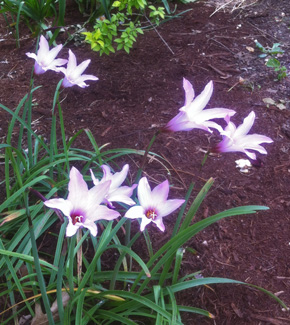Resource Library
Plant of the Week: Lily - Pink Rain, Pink Fairy
Plant of the Week
Pink Rain Lily, Pink Fairy Lily
Latin: Habranthus robustus

Pass-along plants are an important tradition in gardening. About five years ago I was given an odds and ends assortment of bulbs by John C. Gilbreath, an enthusiastic gardener relocating from the Houston area to Northwest Arkansas. He passed away during the winter and this year many of those same bulbs made their first really good show in their new home. One was a rain lily new to me called Habranthus robustus.
Rain lilies are summer and fall blooming bulbs in the Amaryllis family that are divided into three separate genera, the Zephyranthes, the Cooperiaand the Habranthus. Rain lilies earn their common name by flowering during the summer and fall a day or two after a heavy rain. Some species, including Habranthus robustus, bloom several times during the growing season as long as they are exposed to a short drought period between blooming periods.
More than 75 species of Habranthus have been described with all of them of New World origins. This species is native to Southwestern Brazil and adjacent areas of Argentina. It has been in cultivation since the middle of the 19th century. This is the most commonly seen of the species and, because it comes from a region with relatively even amounts of rainfall during the year, tolerates more moisture than many rain lilies.
The pink rain lily in its native habitat produces its foliage at the beginning of the cold season and it persists until summertime heat and drought burns it away. For me, here at the boundary between zones 6 and 7, foliage appears in late winter after the worst winter weather is over. Leaves are about half an inch wide, 12 to 14 inches long and sprawl about on the ground. Bulbs are small, free branching and quickly colonize an area.
“Pink fairy lily,” is a good name because I have mine planted in the fairy garden area at the Botanical Garden of the Ozarks, where it grows from 12 to 18 inches tall on stout scapes with a solitary 4-inch long and wide, pink six-petaled bloom. The tepals (petals) are of different size giving the flower a one-sided appearance. When in bloom the flowers all turn towards the brightest location so all face the same direction. Flowers are produced on and off during early summer through early fall.
This species is usually listed as only hardy in zones 8 through 10 but mine have been in the ground for five years and I’ve read reports from central North Carolina and Oklahoma where the bulb has survived unscathed for a like amount of time. It should be planted in well-drained sites in full sun or part shade. In sunny locations it will be shorter than in the shade.
It is a good addition to the shaded border or can be naturalized in the bare ground beneath large oak trees where grass never quite seems to survive. In colder areas it can also be grown in pots with the plants stored indoors during the winter and placed outside for summertime bloom. Plants produce a lot of seeds which, if planted as soon as the seed capsule is mature, germinate freely. If seeds are allowed to dry out germination may be delayed up to a year.
By: Gerald Klingaman, retired
Retired Extension Horticulturist - Ornamentals
Extension News - August 15, 2014
The University of Arkansas System Division of Agriculture does not maintain lists of retail outlets where these plants can be purchased. Please check your local nursery or other retail outlets to ask about the availability of these plants for your growing area.